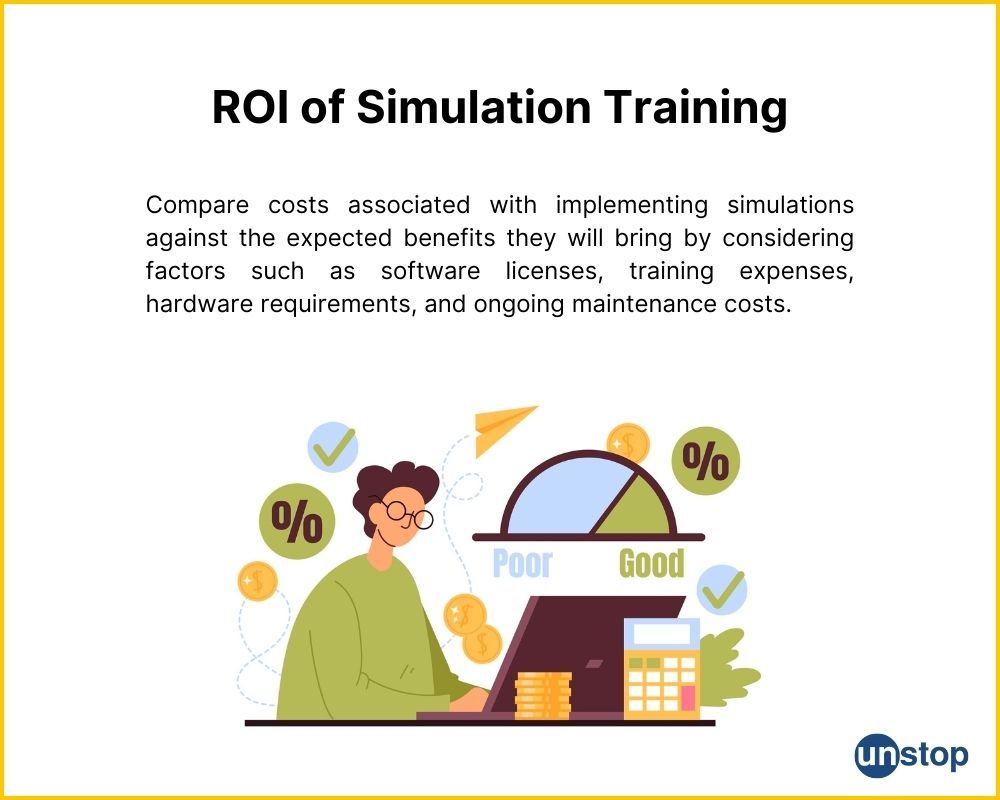- What is Business Simulation Training?
- Questions to Ask Before Investing in Simulations
- Limitations of Simulation in Training
- Evaluating the ROI of Investing in Simulation
- Best Practices for Successful Simulation Implementation
- Conclusion
- Frequently Asked Questions
Questions to Ask Before Investing in Simulation: A Comprehensive Guide

Simulations have gained popularity as a means of assessing employee skills and engagement. They provide a realistic environment to evaluate abilities, allowing individuals to showcase critical thinking, decision-making, and communication skills. Simulations also enhance employee engagement by immersing them in realistic scenarios, increasing motivation and job satisfaction, and boosting learning outcomes.
These assessments can be tailored to specific job roles or industries, ensuring relevance and meaningful insights into an individual's suitability for a particular task. Overall, simulations offer a powerful tool for talent management, accurately evaluating employee abilities while fostering engagement and motivation.
What is Business Simulation Training?
Business simulation is a training method that allows participants to experience real-life business situations in a simulated environment. It involves the use of computer-based simulations or role-playing exercises to mimic the challenges and decision-making processes faced in the business world. By engaging in these simulations, participants can develop their problem-solving, critical thinking, and decision-making skills in a risk-free setting.
Organizations can create simulations for various roles, from marketing to operations. Simulations can also be designed to improve skills like entrepreneurship, strategic thinking, etc.
Benefits of Business Simulation
-
Business simulation training provides a hands-on learning experience that enhances engagement and retention of information.
-
The interactive nature of business simulations fosters a sense of ownership and motivation among employees. They become more invested in the learning process as they see the direct impact of their decisions on the simulated business outcomes.
-
Business simulations often require participants to work together in teams, promoting collaboration, teamwork, and interpersonal skills.
-
Business simulations provide immediate feedback on participants' actions and decisions. Thus, they learn from their mistakes and make adjustments in real-time.
-
Business simulations offer a safe space for employees to experiment with different strategies and approaches. This encourages creativity, innovation, and the exploration of new ideas.
-
The skills developed through business simulation training, such as problem-solving, critical thinking, and decision-making, are highly transferable to different business contexts.
Overall, business simulation training is an effective tool to practically engage employees. Find seven different categories of simulations on Unstop and choose the one that suits you best.

Questions to Ask Before Investing in Simulations

Several considerations need to be considered before using simulations for training, assessing and engaging employers. Asking the right questions can get HRs the insight they need to make an accurate judgment about investing in simulations.
Here are some questions to ask before investing in simulations:
1. Does it align with your learning objectives?
Before investing in simulations, it is crucial to determine the specific problems or decisions that simulations can help address. This ensures alignment with the organization's learning objectives. By clearly defining the goals and outcomes expected from simulations, companies can ensure that their investment will provide tangible benefits.
For example, if the learning objective is to enhance decision-making and problem-solving, simulations can be used to present employees with various scenarios and challenges. They can thus learn how to make informed decisions in a dynamic and ever-changing work environment.
2. How can it integrate with existing systems and processes?
Another important consideration is how simulations will integrate with the organization's existing processes and/or systems. Understanding the compatibility of the simulations allows for a smoother transition and avoids potential disruptions to daily operations.
Investors should assess the level of expertise or external support needed to implement and maintain simulations effectively. Depending on the complexity of the simulation solution, specialized knowledge or assistance may be required. This also includes the efforts required (time and cost) in training facilitators.
Evaluating these requirements beforehand helps in determining whether internal resources are sufficient or if additional support is necessary. This is part of the cost-benefit analysis that every organization must conduct before making any major investment, including investing in simulations.
3. What’s the scope of scalability and customization?
Considering future needs is vital when investing in simulation solutions. Organizations should inquire about the scalability and adaptability of the chosen solution.
Will it be able to accommodate growth? Can it be easily modified to meet evolving requirements? Ensuring flexibility allows for long-term utilization without significant additional investments.
Companies should also assess if simulations or their chosen simulation platform allows for customization i.e. if there is scope to tailor simulations for specific scenarios that may arise in the future.
4. Can it balance knowledge with practical experience?
It is important to understand what aspects are being assessed by simulations. Simulations acts as a bridge between theoretical knowledge and practical application, providing a controlled environment in which employees can practice their skills.
However, without a proper balance between knowledge and practical experience, simulations may not effectively meet the training needs of employees. Can simulations assess that employees have a solid understanding of the concepts before engaging in practical exercises?
For example, in the case of HR-based simulations, it’s also important for users to know compensation structures, company guidelines, etc. before applying the same in real-world scenarios.
Important: Assessing isn’t enough - feedback is also important. Evaluate how feedback is provided in the simulation and whether actionable insights are provided for end users.
5. How can the success of simulation be measured?
Another key consideration before investing in a simulation is to understand how success will be measured. Investors should inquire about the feedback mechanism incorporated into the simulation solution and what data points are provided by simulations.
For example, you have clearly defined key performance indicators (KPIs) that align with your engagement goals. But does the simulation provide data on the set KPIs? Gathering feedback from employees before and after the simulation can also help you understand the success of the simulation.
6. What’s the degree of user accessibility?
Accessibility plays a crucial role in user adoption and engagement. Assessing how accessible and easy-to-use a simulation solution is for all users ensures maximum participation across different levels within an organization.
To understand the degree of user accessibility, organizations need to understand the workforce demographic, along with their specific needs and interests:
- Consider the age, experience level, and technical skills of your employees.
- Choose a simulation that is both challenging and engaging for your target audience.
- Be mindful of accessibility and inclusivity when selecting the simulation platform and format.
These are some of the questions to ask before investing in simulations. However, depending on your needs, end goal and workforce, you may have additional questions to ask before investing in simulations.
Limitations of Simulation in Training

Using business simulations for training and employee engagement can be a valuable tool, but it is important to be aware of the risks and limitations associated with this approach.
Oversimplification of complex, real-world environment
One of the main risks is that simulations may not accurately reflect the complexities and nuances of real-world business situations. While simulations can provide a controlled environment for learning, they may oversimplify or overlook important factors that can impact decision-making in the real world. This can lead to a false sense of confidence among trainees, who may struggle to apply what they have learned when faced with actual business challenges.
Can’t replicate emotional aspects of business interactions
In a simulated environment, trainees may not experience the same level of pressure, stress, or emotional investment that they would in real-life scenarios. This can hinder the development of skills such as negotiation, conflict resolution, and leadership, which are essential for success in the business world.
Resource Intensive
Simulations can be time-consuming to develop and implement. They require significant investment in technology, software, and training materials, as well as dedicated facilitators or instructors. This can make simulations cost-prohibitive for some organizations, especially smaller ones with limited budgets.
While business simulations can be a valuable tool for training and employee engagement, it is important to carefully consider their risks and limitations to ensure that they are used effectively and in conjunction with other training methods.
Evaluating the ROI of Investing in Simulation

Calculating the return on investment (ROI) is essential before making any significant financial commitment.
When evaluating simulation investments, it is necessary to compare the costs associated with implementing simulations against the expected benefits they will bring. This includes considering factors such as software licenses, training expenses, hardware requirements, and ongoing maintenance costs.
By quantifying both the upfront investment and projected returns from enhanced efficiency or increased productivity, businesses can determine if simulation investments are financially viable.
Best Practices for Successful Simulation Implementation
Engaging Stakeholders Throughout the Process
Involve key individuals from various departments so that their insights are incorporated into the simulation design. This collaborative approach not only increases buy-in but also enhances the accuracy and relevance of the simulation.
Stakeholders should be included right from the planning phase. This ensures their specific needs and goals are understood.
Regular communication and feedback sessions throughout the implementation process will help address any concerns or challenges that arise. By keeping stakeholders informed and involved, you can ensure that they remain invested in the simulation's success.
Using Real-World Data and Feedback to Refine Simulations
Validate and refine simulation models using real-world data and feedback. Collecting relevant data from actual operations allows you to calibrate your simulation model to reflect realistic scenarios accurately. This validation process helps identify any discrepancies or gaps between simulated outcomes and real-life experiences.
Gathering feedback from end-users who interact with the simulation is equally important. Their insights can provide valuable information on areas that may require improvement or adjustment. By incorporating this feedback into your simulation model, you can enhance its accuracy and effectiveness.
Regularly Reviewing and Updating Simulation Strategies
Business environments are constantly evolving, which means that simulation strategies must also adapt accordingly. Regularly reviewing your simulation strategies ensures they align with changing business needs, technological advancements, market trends, or regulatory requirements.
Conclusion
In conclusion, simulations are a valuable tool for training as they provide a realistic and immersive learning experience. However, before investing in simulation training, it is important to consider factors such as cost, accessibility, and alignment with specific training objectives.
Additionally, to safeguard against common limitations, it is crucial to regularly update and maintain the simulation software, provide thorough training for facilitators, and continuously evaluate and improve the simulation program.
Frequently Asked Questions
1. What is simulation training for employee engagement?
Simulation training for employee engagement is an interactive learning experiences that simulate real-life scenarios to enhance employee skills, knowledge, and engagement. These trainings use virtual environments, role-playing exercises, and other immersive techniques to provide employees with a hands-on learning experience.
2. Are simulation training suitable for all types of industries?
Yes, simulation training can be customized to suit the needs of various industries. Whether you're in healthcare, finance, manufacturing, or any other industry, simulation training can be tailored to address specific challenges and objectives. The flexibility of simulation training allows for industry-specific scenarios and simulations that resonate with employees and help them apply their learning in real-world situations.
3. How can simulation training improve employee retention?
Simulation training can contribute to improved employee retention by providing employees with a sense of growth and development. When employees feel that their skills are being nurtured and they have opportunities to learn and improve, they are more likely to stay engaged and committed to their organization. Simulation training also creates a positive learning culture within the organization, which fosters employee loyalty and satisfaction.
4. Can simulation training replace traditional training methods?
Simulation training should be seen as a complement to traditional training methods rather than a replacement. While traditional training methods such as classroom sessions and e-learning modules have their own benefits, simulation training offers a unique experiential learning opportunity. By combining different training approaches, organizations can create a comprehensive and effective learning experience for their employees.
Suggested Reads
- How Simulations Help In Developing Economics Skills Among Students & Employees?
- Experiential Learning: Meaning | Benefits | Role Of Business Simulation
- On-the-Job Training vs Simulations: A Comparative Analysis
- Upskill And Reskill: The Learning Approaches Shaping Professional Development Today
- Five Ways Business Simulations Boost Learning Outcomes
I’m a reader first and a writer second, constantly diving into the world of content. If I’m not writing or reading, I like watching movies and dreaming of a life by the beach.
Login to continue reading
And access exclusive content, personalized recommendations, and career-boosting opportunities.
Subscribe
to our newsletter
Blogs you need to hog!

Organize Hackathons: The Ultimate Playbook With Past Case Studies

What is Campus Recruitment? How To Tap The Untapped Talent?

Lateral Hiring: A Complete Guide To The Process, Its Benefits, Challenges & Best Practices













Comments
Add comment